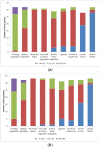Enough to Feed Ourselves!-Food Plants in Bulgarian Rural Home Gardens
- PMID: 34834883
- PMCID: PMC8623271
- DOI: 10.3390/plants10112520
Enough to Feed Ourselves!-Food Plants in Bulgarian Rural Home Gardens
Abstract
The home garden is a unique human-nature interspace that accommodates a diverse spectrum of plant species and provides multiple services to households. One of the most important roles of home gardens is to shelter the agricultural plant diversity that provides for diverse and healthy nutrition, especially in rural communities. While tropical home gardens have received wide recognition due to their provisional function for the local communities, temperate and especially European home gardens have been discussed less frequently as a source of subsistence. The main objectives of the current study were to document plant species grown in Bulgarian rural home gardens and to explore related local knowledge and cultural practices that influence food plant diversity, its selection and preservation. Field work was focused on settlements situated in eight provinces in South and North-West Bulgaria. Participants representing 65 home gardens were approached through semi-structured interviews. Home gardens were found to harbor 145 cultivated and semi-cultivated plant taxa, used as food, medicinal and aromatic plants and as animal fodder. Members of the Rosaceae family were most numerous. The largest part of the garden area was occupied by vegetable crops of Solanaceae and Cucurbitaceae. In 63.1% of the studied households, the food growing area comprised more than 2/3 of the total size of the garden. Most preferred crops reflected the social and cultural importance of food self-provisioning, especially in the rural areas. The provisional role of the home gardens in regard to preparation of traditional foods and the driving forces for seed saving are discussed.
Keywords: ethnobotany; home gardens; self-provision; subsistence; traditional food.
Conflict of interest statement
The authors declare no conflict of interest.
Figures
References
-
- Engels J. Home gardens—A genetic resources perspective. In: Watson J.W., Eyzaguirre P.B., editors. Proceedings of the Second International Home Gardens Workshop: Contribution of Home Gardens to in Situconservation of Plant Genetic Resources in Farming Systems, Witzenhausen, Germany, 17–19 July 2001. International Plant Genetics Research Institute; Rome, Italy: 2002. pp. 3–10.
-
- Gautam R., Suwal R., Sthapit B.R. Securing family nutritition through promotion of home gardens: Underutilized production systems in Nepal. Acta Hortic. 2009;806:99–106. doi: 10.17660/ActaHortic.2009.806.10. - DOI
-
- Jones G. Garden cultivation of staple crops and its implications for settlement location and continuity. World Archaeol. 2005;37:164–176. doi: 10.1080/00438240500094564. - DOI
-
- Nifiez V.K. Household Gardens: Theoretical Considerations on An Old Survival Strategy. International Potato Center; Lima, Peru: 1984.
-
- Galluzzi G., Eyzaguirri P., Negri V. Uncovering European home gardens: Their human and biological featurs and potential contribution to the conservation of agro-biodiversity. In: Bailey A., Eyzaguirre P., Maggioni L., editors. Crop Genetic Resources in European Home Gardens. Bioversity International; Rome, Italy: 2009. pp. 8–17.
Grants and funding
LinkOut - more resources
Full Text Sources


